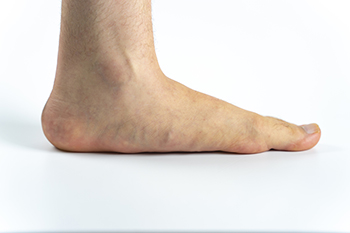Items filtered by date: June 2023
Dealing With Clubfoot in Babies

Clubfoot is a congenital foot defect that can be detected before birth, but usually is diagnosed after the baby is born. Soon thereafter, treatment can begin. A clubfoot, also called talipes, is characterized by the foot pointing down and inward with the sole facing backward. It can affect one or both feet, but is not painful for babies. A treatment called the Ponseti method is frequently the first step in correcting clubfoot. During this process, the baby’s foot is manipulated into the correct position and placed in a cast. The process is repeated frequently as the baby grows. After the cast is permanently removed, minor surgery may be required to loosen the Achilles tendon. After that, the baby will wear special boots to prevent the clubfoot from returning. These boots will be worn daily for three months, and then as the baby ages, the boots are worn at night until they are about five years old. Most babies respond well to this treatment, and begin to walk normally. For further information about clubfoot, it is suggested that you consult a podiatrist.
Congenital foot problems require immediate attention to avoid future complications. If you have any concerns, contact one of our podiatrists of Podiatry Associates of Texas. Our doctors can provide the care you need to keep you pain-free and on your feet.
Congenital foot problems are deformities affecting the feet, toes, and/or ankles that children are born with. Some of these conditions have a genetic cause while others just happen. Some specific foot ailments that children may be born with include clubfeet, polydactyly/macrodactyly, and cleft foot. There are several other foot anomalies that can occur congenitally. What all of these conditions have in common is that a child may experience difficulty walking or performing everyday activities, as well as trouble finding footwear that fits their foot deformity. Some of these conditions are more serious than others. Consulting with a podiatrist as early as possible will help in properly diagnosing a child’s foot condition while getting the necessary treatment underway.
What are Causes of Congenital Foot Problem?
A congenital foot problem is one that happens to a child at birth. These conditions can be caused by a genetic predisposition, developmental or positional abnormalities during gestation, or with no known cause.
What are Symptoms of Congenital Foot Problems?
Symptoms vary by the congenital condition. Symptoms may consist of the following:
- Clubfoot, where tendons are shortened, bones are shaped differently, and the Achilles tendon is tight, causing the foot to point in and down. It is also possible for the soles of the feet to face each other.
- Polydactyly, which usually consists of a nubbin or small lump of tissue without a bone, a toe that is partially formed but has no joints, or an extra toe.
- Vertical talus, where the talus bone forms in the wrong position causing other bones in the foot to line up improperly, the front of the foot to point up, and the bottom of the foot to stiffen, with no arch, and to curve out.
- Tarsal coalition, when there is an abnormal connection of two or more bones in the foot leading to severe, rigid flatfoot.
- Cleft foot, where there are missing toes, a V-shaped cleft, and other anatomical differences.
- Macrodactyly, when the toes are abnormally large due to overgrowth of the underlying bone or soft tissue.
Treatment and Prevention
While there is nothing one can do to prevent congenital foot problems, raising awareness and receiving neonatal screenings are important. Early detection by taking your child to a podiatrist leads to the best outcome possible.
If you have any questions please feel free to contact our offices located in Arlington Weatherford, Mineral Wells, and Farmers Branch, TX . We offer the newest diagnostic tools and technology to treat your foot and ankle needs.
Young Runners and Burnout

Parents and coaches that are involved in youth running may find one of their runners may be on the verge of burning out. This is defined as having prolonged frustration, which may lead to becoming emotionally and physically exhausted. Some of the symptoms that are associated with burnout can include a lack of motivation, mood changes, and chronic fatigue. It is important to prevent running injuries from occurring, and this can be accomplished by ensuring that young athletes get adequate sleep. Additionally, it is beneficial to promote healthy eating habits, and warming up before running can keep the body limber. Burnout may be prevented by making sure there is enough recovery time, and it may be helpful to change the race distance, in addition to promoting other activities. Running injuries can impact the feet, and can temporarily halt running. If you would like more information about how to implement running injury prevention techniques, it is suggested that you confer with a podiatrist.
Exercising your feet regularly with the proper foot wear is a great way to prevent injuries. If you have any concerns about your feet, contact one of our podiatrists of Podiatry Associates of Texas. Our doctors will treat your foot and ankle needs.
How to Prevent Running Injuries
Many common running injuries are caused by overuse and overtraining. When the back of the kneecap starts wearing out and starts causing pain in your knee, this is commonly referred to as runner’s knee. Runner’s knee is a decrease in strength in your quadriceps and can occur if you’re not wearing properly fitted or supporting shoes. To prevent runner’s knee, focusing on hip strengthening is a good idea, as well as strengthening your quads to keep the kneecaps aligned.
What Are Some Causes of Running Injuries?
- One cause of a common running injury is called iliotibial band syndrome.
- Plantar fasciitis is also another common injury.
- Stress fractures can occur from overtraining, lack of calcium, or even your running style.
Best Ways to Prevent Running Injuries
- Wear footwear that fits properly and suits your running needs.
- Running shoes are the only protective gear that runners have to safeguard them from injury.
- Make a training schedule. Adding strengthening exercises as well as regular stretching can help keep you strong and limber and can lessen the possibility of injuries.
- Stretching keeps muscles limber; this will help you gain better flexibility.
If you have any questions please feel free to contact our offices located in Arlington Weatherford, Mineral Wells, and Farmers Branch, TX . We offer the newest diagnostic and treatment technologies for all your foot and ankle needs.
Why the Bottom of Your Feet May Hurt

If you have pain in the bottom of your feet, you may be wondering why that is. You might be feeling sharp pains or throbbing soreness. Given how complex the feet are and the many bones, joints, muscles, and ligaments they have, there are many reasons this can happen. One possibility is that you are experiencing symptoms of flat feet. This is the foot condition when the entire sole touches the ground. The types of flat feet are flexible and rigid flat feet. Flexible flat foot is the most common and occurs when the foot is only flat when weight is put on it. Rigid flat foot is flat whether weight is put on the foot or not. This latter type of flat feet may be from the tarsal coalition, which is an ailment where bones have grown together. Additionally, congenital conditions or arthritis may lead to having flat feet. The correct treatment depends on the type of flat foot you have. Relief may be found by stretching the foot, strengthening the arch, or wearing orthotics. Surgery may also be a possibility for permanent relief. If you have flat feet and they are causing you pain, it is suggested that you see a podiatrist for an evaluation and a proper treatment plan.
Flatfoot is a condition many people suffer from. If you have flat feet, contact one of our podiatrists from Podiatry Associates of Texas. Our doctors will treat your foot and ankle needs.
What Are Flat Feet?
Flatfoot is a condition in which the arch of the foot is depressed and the sole of the foot is almost completely in contact with the ground. About 20-30% of the population generally has flat feet because their arches never formed during growth.
Conditions & Problems:
Having flat feet makes it difficult to run or walk because of the stress placed on the ankles.
Alignment – The general alignment of your legs can be disrupted, because the ankles move inward which can cause major discomfort.
Knees – If you have complications with your knees, flat feet can be a contributor to arthritis in that area.
Symptoms
- Pain around the heel or arch area
- Trouble standing on the tip toe
- Swelling around the inside of the ankle
- Flat look to one or both feet
- Having your shoes feel uneven when worn
Treatment
If you are experiencing pain and stress on the foot you may weaken the posterior tibial tendon, which runs around the inside of the ankle.
If you have any questions please feel free to contact our offices located in Arlington Weatherford, Mineral Wells, and Farmers Branch, TX . We offer the newest diagnostic and treatment technologies for all your foot and ankle needs.
Exercise and Foot Problems Related to Obesity

Obesity, or being overweight, bears a strong connection to a variety of different foot conditions. This is due to the fact that carrying extra weight can exert more pressure than is healthy on the feet, leading to foot pain and other conditions. Although exercise is an obvious way in which an obese individual can lose weight, it may be difficult to exercise due to foot problems. This leads to an unfortunate circular problem. One way to address this issue is by engaging in exercise activities that are not weight-bearing until the foot pain goes away. For example, an individual struggling with obesity can circumvent foot problems while exercising by engaging in swimming. If you are someone that is obese and is experiencing foot problems, it is suggested that you consult a podiatrist today for more information and guidance.
Obesity has become very problematic at this point in time and can have extremely negative effects on the feet. If you’re an obese individual and are concerned about your feet, contact one of our podiatrists from Podiatry Associates of Texas. Our doctors can provide the care you need to keep you pain-free and on your feet.
Obesity and Your Feet
Since your feet are what support your entire weight when standing, any additional weight can result in pain and swelling. Being overweight is one of the main contributors to foot complications.
Problems & Complications
Extra Weight – Even putting on just a few extra pounds could create serious complications for your feet. As your weight increases, your balance and body will shift, creating new stresses on your feet. This uneven weight distribution can cause pain, even while doing the simplest tasks, such as walking.
Diabetes – People who are overweight are at serious risk of developing type-2 diabetes, which has a drastic impact on the health of your feet. As you get older, your diabetes might worsen, which could lead to loss of feeling in your feet, sores, and bruises. You could also become more prone to various infections.
Plantar fasciitis – Pressure and stress that is placed on muscles, joints, and tendons can trigger plantar fasciitis, which is an inflammation of tissue that forms along the bottom of the foot.
If you have any questions please feel free to contact our offices located in Arlington Weatherford, Mineral Wells, and Farmers Branch, TX . We offer the newest diagnostic and treatment technologies for all your foot and ankle needs.

